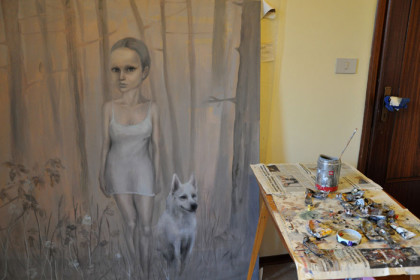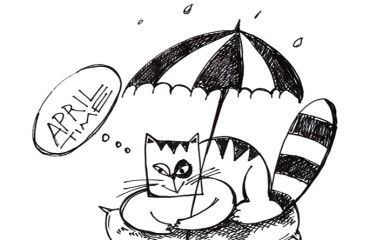
Women in white petticoat that reveals tiny bodies – almost childish – fragile, diaphanous bodies expressing loneliness, faces magnified and bright eyes looking straight ahead with firmness and decision. And then animals: fierce or wild and sweet or domestic, flanked by female figures, without even a communication or dialogue ever. Everything, in the paintings by Ludmila Kazinkina, is located in an intimate atmosphere, a sort of gray-blue fog that surrounds and cancels space, leaving only unsettling details or pale horizons.
“I tell stories when I paint”, explains the artist in front of a work in progress, and it is clear that her intent is to give meaning to the paintings and drawings, to tie them to a deep reflection on the status of women, the relationship of Western society with animals, on the thinking that now prevails on the doing. Her disturbing silent women, with pained glance, query themselves and interrogate those who look at them about physical or psychological violence, of which they are victims. As the body gets smaller, cowers and seeks protection, the head extends because it contains the ability to think, or could contain even when left empty. But not being able to deny the “bestiality” of human being, this is manifested outwardly in animals that are also images of the unconscious, dreams and nightmares.
In Ludmila’s works often appear tapes, wires and cobwebs that seem to tie the figures imprisoning them in a cage that surrounds them or build a functional speech to reveal lies, as in the light series – because made of polystyrene, cloth of linen and mild gauze – “Stories sewn with a white thread”, a title taken from a Russian way of saying: the lie is like a white stitching, you see it right away.
Ludmila is in fact Russian, she has settled in Italy for ten years but carries out projects in Asia (Singapore, Beijing, where is ongoing an exhibition) and for the next few months will engage in organizing a cultural festival including an exihibition in Salekhard, north of Russia, a town located exactly on the Arctic Circle: a place where the temperature can reach minus 40 degrees and where people live in what could be called, seen from here, “another world”, a world in which belongs to shamans the decision on the date of the great feast of the reindeer. The artist will bring her women, will make them perhaps more savage, more natural linking them even more to references that always accompany them, among all the films Tarkovsky’s Solaris.
The cabinet in her studio is full of works, projects, large-scale paintings are rolled up since she moved from a country cottage apartment in the center, in the corners of the rooms the paintings – “many are abroad, exhibitions” – have accumulated under protective cloth and retain their strength, their stories; they seem ready to be unveiled, becoming carriers of messages and meanings.
 English
English  Italiano
Italiano 



